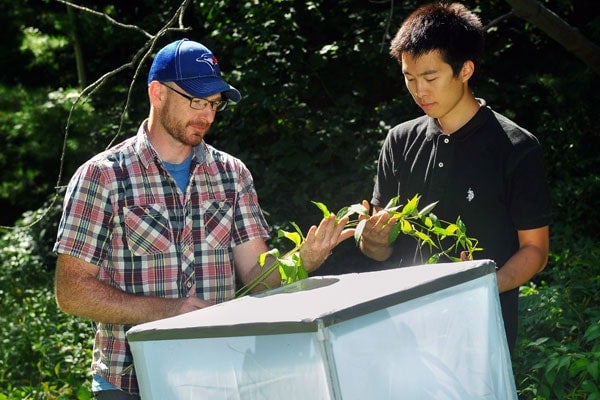
Hungry caterpillar? U of T researchers enlist tiny ally in fight against invasive plant species
Published: September 9, 2014
Invasive plants: they're bad news for Canada’s ecosystems and economy. A challenge for gardeners and farmers, they also take a huge toll on municipalities that must spend money eradicating them.
The problem with invasive species is so bad that Ontario is developing stand-alone legislation just to deal with unwanted species of plants, says Sandy Smith. The University of Toronto professor is part of an international team of researchers working to fight an invasive plant that raises the ire of urban gardeners: dog-strangling vine (DSV), so named because it strangles other vegetation, crowds out native plants and interferes with the natural growth of trees.
“DSV is a major invasive plant throughout the cities of Toronto and Ottawa, along with many other smaller municipalities, small landowners and land trust properties in southern Ontario and eastern North America,” says Smith, an entomologist with the Faculty of Forestry. “These municipalities spend big dollars to manage it and other invasive plants by mechanically pulling or using chemical herbicides, both which are ineffective and costly.”
Thought to have been brought to North America from Ukraine in the 1800s, DSV has now become a significant ecological threat to Canadian habitats and rare species. To make matters worse, the weed spreads rapidly, is toxic to insects and isn’t known to have any natural enemies in North America.
To the rescue of the ecosystem comes an unlikely hero, the Hypena caterpillar.
Native to Ukraine, the insect was first identified as a possible defence against DSV in 2006. Since then, it has undergone extensive testing by an international team of researchers, including Smith, Adjunct Professor Rob Bourchier, and University of Toronto Scarborough Associate Professor Marc Cadotte, to confirm that it survives on DSV and won’t feed on native plants.
After eight years of research, the very first field releases of Hypena caterpillars in North America were done at several DSV-infested sites throughout Ontario.
Smith says that once established at the initial sites, Hypena moths will disperse to find new patches of DSV. And it’s hoped they will give birth to a new generation of caterpillars to nibble away on the invasive plant.
"And because the Hypena can only survive on DSV, their populations will rise and fall with the availability of their host plant,” she explains.
Adds Bourchier, “Like the Panda Bear, these caterpillars have only one food choice.”
Cadotte, who explores the role invasive species play in urban ecosystems, reared the caterpillars in his lab at UTSC. He says the next challenge will be whether the caterpillars are successful enough to survive the winter and reproduce.

(Above photo by Stuart Livingstone.)
“These species are native to the Ukraine, so they should be able to adapt to a Canadian winter,” says Cadotte, adding the caterpillar could play a vital role.
"DSV severely reduces native plant diversity and the pollinator populations that depend on those plants, which is now a major conservation issue in Canada."
Researching the Hypena caterpillar was done by Agriculture and Agri-Food Canada, in collaboration with scientists at the University of Toronto, Carleton University, the University of Rhode Island, the Ontario Ministry of Natural Resources, the Commonwealth Agricultural Bureaux International (CABI) in Switzerland, and the forest management company SilvEcon Inc.
Smith, Bourchier and Cadotte hope that within three years, the Hypena caterpillar will be well on its way to eradicating DSV. So far, the caterpillar has proved to be a success.
Don Campbell is a writer with the University of Toronto Scarborough; Dominic Ali writes about cities for U of T News.



